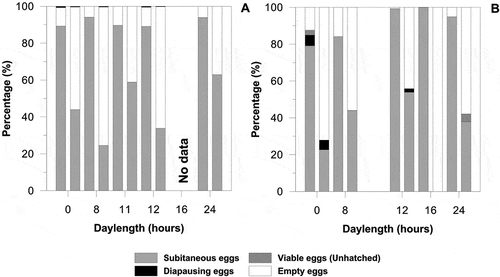Figures & data
Figure 1. A, description of the induction system (1, photoperiod of 8:16 light:dark; 2, 12:12; 3, 16:8; 4, 24:0; 5, no condition; 6, 0:24). B, electrical mechanism. C, compartment with beaker and lighting system. D, zoom on the lighting system [two light-emitting diodes (LEDs)].
![Figure 1. A, description of the induction system (1, photoperiod of 8:16 light:dark; 2, 12:12; 3, 16:8; 4, 24:0; 5, no condition; 6, 0:24). B, electrical mechanism. C, compartment with beaker and lighting system. D, zoom on the lighting system [two light-emitting diodes (LEDs)].](/cms/asset/cbf412c9-690f-4e58-b727-f09941204370/tizo_a_861024_f0001_oc.jpg)
Table I. Number of subitaneous (S), diapausing (D), non-viable (Non) and full but non-hatched (Fnh) eggs produced by females raised from naupliar instars (N1–N3) under six photoperiods at 12 and 16°C. The number of eggs was counted for the first and the second clutch. For each clutch, the number of females (N) obtained from naupliar instars and producing the different kind of eggs was indicated. (–) missing data. The correlation between photoperiod and clutch size (# subitaneous eggs/female/clutch) was only observed for the first clutch at 16°C (Spearman rho = 1, p < 0.001).
Figure 2. Percentage of different kind of eggs (subitaneous eggs, diapausing eggs, full but non-hatched eggs and non viable eggs) produced by Eurytemora affinis under 5–6 photoperiods at (A) 12°C and (B) 16°C. For each photoperiod condition, the first histogram corresponds to the first clutch, and the second histogram to the second clutch.

Table II. Percentage of subitaneous (S), diapausing (D), non-viable (Non) and full but non-hatched (Fnh) eggs produced by females raised from naupliar instars (N1–N3) under two photoperiods at 12 and at 16°C, then switched to the opposite photoperiod during instar (N6-C1). The number of eggs was counted for the first and the second clutch. For each clutch, the number of females (N) obtained from naupliar instars and producing the different kind of eggs was indicated. (–) missing data.